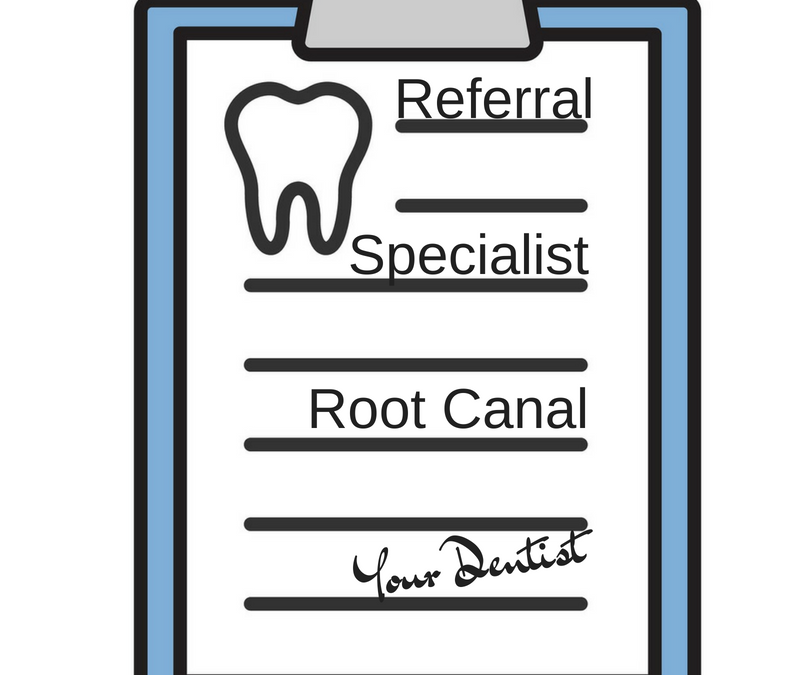
by Dr. Jacqueline S. Allen | Aug 24, 2018 | Blog, Endodontics, Root Canal
Roo t canals are a type of endodontic procedure designed to save a patient’s natural tooth. An endodontic specialist or a general dentist treats an injured or infected tooth by cleaning the canals of the tooth root of their pulp and replacing it with a compound known as gutta-percha.
t canals are a type of endodontic procedure designed to save a patient’s natural tooth. An endodontic specialist or a general dentist treats an injured or infected tooth by cleaning the canals of the tooth root of their pulp and replacing it with a compound known as gutta-percha.
This procedure has a success rate upwards of 90 percent and can make a dramatic positive difference in a patient’s oral health. However, if you’ve been referred to an endodontist for a root canal, it’s only natural to wonder what your recovery period will look like. We asked Dr. Jacqueline S. Allen, an endodontist who practices with the Phoenix Endodontic Group, to explain what most patients can expect after a root canal.
Root Canal Recovery: What To Expect
- Your root canal should lessen any tooth-related pain you have been feeling. Some extra sensitivity may remain if you were previously feeling pain from an infection or injury, but that should respond to over-the-counter or prescription painkillers.
- You will need to avoid chewing with the treated tooth at first. Your root canal will have a temporary filling on top of it to seal the canals, but until you receive a permanent restoration such as a crown, you will need to minimize chewing with the treated tooth.
- You will want to continue your usual oral self-care regimen. Brush twice a day and floss daily to maintain the health of your entire mouth. Follow your dental provider’s recommended schedule for follow up appointments once your restoration is in place.
- You may return to normal activities the day after your root canal. You should be able to return to work or participate in most types of recreational activities you may have scheduled.
Despite advances in endodontic clinical technique and dental technology, not all root canals are successful. If a canal is not found and filled during the initial procedure, or if the tooth is challenged by a new infection or injury later on, you may need a root canal retreatment. It’s essential to alert your endodontist if discomfort returns to the tooth treated by the root canal.
“Many patients suffer unnecessary anxiety related to recovery from their root canal,” says Dr. Allen. “But recovery goes smoothly for most people, and a patient only has to observe a few extra precautions to ensure the success of their procedure.”
by Dr. Jacqueline S. Allen | Jul 26, 2018 | Blog, Endodontics, Endodontist, Phoenix Endodontic Group, Root Canal
Just as it is important to be an informed consumer when you go shopping, if you have been referred to a Phoenix endodontist for a root canal, you should ask questions of your provider about the procedure. Your experience with the root canal may be more pleasant and less confusing if you take the time to arm yourself with accurate answers to the following three questions.
Top 3 Questions To Ask Your Phoenix Endodontist About Your Root Canal
- What is the reason for my root canal? There are many reasons an endodontist might use root canal treatment to save your natural tooth: you could be experiencing a challenge to your tooth pulp due to a cracked or chipped tooth, advanced tooth decay, dental trauma that knocked your tooth out of the socket, or a bacterial infection. Understanding the cause may help avoid the need to perform root canals on other teeth.
- How much experience do you have performing root canals? With the average general dentist providing two root canals per week and the average Phoenix endodontist averaging 25 procedures per week, it helps to know how experienced your provider is. Studies show that patients who had their root canal performed by an endodontist experienced treatment success in 98 percent of all cases.
- How can I participate in making my root canal successful? Once you are clear on why your root canal is being performed and your provider’s experience level, one of the most crucial questions you can ask relates to what YOU can do to help make it successful. Almost all root canals need a final restoration after the procedure to ensure the root canal succeeds, so your commitment to having that work completed is essential.
“If you want to boost the chances that your root canal will be successful, you can do more than just make an appointment with a qualified Phoenix endodontist – please ask questions,” says Dr. Allen, who practices with the Phoenix Endodontics Group. “Your participation makes you an active part of your treatment team.”

by Dr. Jacqueline S. Allen | Jun 25, 2018 | Blog, Dentistry, Endodontics, Endodontist, General Information, Root Canal
 If your general dentist has recommended that you call an endodontic provider about having a root canal performed, you’re far from alone. The American Association of Endodontists reports that more than 15 million root canals are performed every year – that’s more than 41,000 root canals per DAY.
If your general dentist has recommended that you call an endodontic provider about having a root canal performed, you’re far from alone. The American Association of Endodontists reports that more than 15 million root canals are performed every year – that’s more than 41,000 root canals per DAY.
Why is this procedure done so often to treat an injured or infected natural tooth? There are several reasons why root canals have become a treatment of choice.
Why Is A Root Canal Being Recommended For Me?
- Your dentist or endodontist has determined your natural tooth can be saved. With more than three-quarters of all Americans indicating a preference for saving a tooth over replacing it with an implant, your provider will likely lean in the direction of seeing if salvaging the tooth is possible with a root canal treatment.
- Root canal success rates are comparable with those of dental implants. In both situations, the treatments are successful more than 90 percent of the time.
- Modern root canals are safe, effective and cause little discomfort. Many times, patients come to an endodontist with an infected tooth that has damaged tissues that are causing discomfort. A root canal actually alleviates this discomfort, rather than causing more. Most patients experience about as much discomfort during a root canal as they would getting a cavity filled.
- Nothing can replace the look or function of a natural tooth. Artificial restorations such as dental implants have their advantages, but retaining a natural tooth through a root canal can ensure the tooth stays in your mouth for a lifetime.
“Root canals are neither exotic nor risky,” says Dr. Jacqueline S. Allen, who practices with the Phoenix Endodontic Group. “Endodontists perform this health-enhancing procedure on a daily basis and can make your experience comfortable and stress-free.”
by Dr. Jacqueline S. Allen | Apr 17, 2018 | Blog, Dentistry, Endodontics, Endodontist, General Information, Phoenix Endodontic Group, Root Canal
Many of us love a good mystery novel or television show, but few people enjoy mysteries that revolve around our teeth. If you went to your general dentist to resolve a nagging dental issue, you may be wondering why he or she sent you to an endodontist for further examination and treatment.
Endodontists are dental specialists who focus on treating diseases of the dental pulp. They are experts in restoring infected or injured natural teeth to health. The procedures that they perform for patients also make them quite knowledgeable about reducing and eliminating dental pain.
If your dentist has referred you to an endodontist, here are some of the most common reasons he or she may have done so.
Top Reasons For Referral To An Endodontist
- Your dentist suspects that you need a root canal. If you have the symptoms of infected tooth pulp, your dentist will most likely want the endodontist to conduct an examination and potentially perform a root canal.
- Your dentist may want to have the endodontist examine a previous root canal. Root canal treatments, when followed by the addition of a dental crown on top, have success rates that exceed 90 percent. But root canals can fail, and when they do, an endodontist is the professional most experienced in performing a root canal retreatment.
- You may have a cracked tooth. Teeth cracks can let in bacterial infection that can damage the tooth’s pulp. In many cases, root canals performed by an endodontist are the only thing that can preserve a natural tooth that has suffered a crack.
- You may need an apicoectomy. If a previous root canal has failed, the damaged tooth may need an apicoectomy, which fills and seals the root tip of the tooth from the root end of the tooth (rather than from the crown end of the tooth, as in a typical root canal).
“Dentists and endodontists work together as a team to keep your natural teeth healthy and intact,” says Dr. Jacqueline S. Allen, who practices with the Phoenix Endodontic Group. “If you have any questions about your referral, let our office know and we will provide a detailed explanation of your condition and your options for treatment.”

by Dr. Jacqueline S. Allen | Mar 15, 2018 | Blog, Endodontics, General Information, Root Canal, Technology
 Endodontists are fond of emphasizing that endodontic therapies such as root canals preserve your natural teeth, allowing you to chew, speak and eat without the downsides that come with dentures or other forms of dental restorations. Most current endodontic therapy preserves the outside of a natural tooth by placing a crown over it, while replacing the failing nerve and pulp in the canals with the latex filling gutta-percha.
Endodontists are fond of emphasizing that endodontic therapies such as root canals preserve your natural teeth, allowing you to chew, speak and eat without the downsides that come with dentures or other forms of dental restorations. Most current endodontic therapy preserves the outside of a natural tooth by placing a crown over it, while replacing the failing nerve and pulp in the canals with the latex filling gutta-percha.
However, one of the most exciting developments in professional endodontics in the past generation has been research into regenerative endodontic therapy. Instead of replacing the nerve pulp with an inert substance, this groundbreaking treatment creates and delivers healthy living tissue to replace diseased, missing or traumatized pulp.
Endodontists who are at the forefront of this research combine their knowledge of pulp biology, the proper care of dental trauma, and tissue engineering to accomplish this task. The body’s own existing cells or bioactive materials are inserted in the pulp chamber to stimulate regrowth. A related procedure, apexification, employs similar methods to grow a dentin-like substance over the apex (tip) of the tooth root, in order to improve the chances of a traditional root canal treatment succeeding when the death of the pulp in a developing adult tooth has left an open apex.
Endodontic practitioners measure the success of regenerative endodontic therapy by its ability to achieve the following treatment goals:
- Elimination of symptoms
- Increased root wall thickness and/or root length
- Positive response to pulp vitality testing
While this technique is still evolving, endodontists are following the progress of its development with great interest.
“Regenerative endodontic therapy opens the door to transforming how we approach saving natural teeth,” says Dr. Allen, an endodontist in private practice with the Phoenix Endodontic Group. “It truly may lead to a clinical situation in which we facilitate the body healing itself.”

by Dr. Jacqueline S. Allen | Nov 13, 2017 | Blog, Endodontics, Endodontist, General Information, Root Canal
 Like most health-enhancing procedures, the technologies and techniques used to provide root canals have been steadily advancing, especially over the past few decades. Today’s root canal procedure is considerably easier on patients than it was in the 1980s, or even the 1990s.
Like most health-enhancing procedures, the technologies and techniques used to provide root canals have been steadily advancing, especially over the past few decades. Today’s root canal procedure is considerably easier on patients than it was in the 1980s, or even the 1990s.
Something that may surprise you, however, is that root canals have been around for well over a century. Here’s a brief list of historical milestones related to root canal procedures, to foster appreciation for how they have developed.
Important Dates In Root Canal History
- 1728 – Pierre Fauchard, a French physician regarded as the father of modern dentistry, authors the book “Le chirurgien dentiste,” which describes the existence of dental pulp.
- 1838 – American Edwin Maynard creates the first root canal instrument, which he fashions from a watch spring.
- 1847 – Gutta-percha is introduced as a material for filling dental canals.
- 1890s – Crowns are becoming increasingly popular as a dental restoration. Many require canal posts, which increases interest in endodontic treatments such as root canals.
- 1900 – The emerging imaging technology of X-rays is identified as an important tool for diagnosing tooth root problems.
- 1943 – The American Association of Endodontics is established to facilitate professional practice in this specialty.
- 1950s – After a half-century of controversy, research establishes that natural teeth needing root canals do not cause systemic health problems, leading to a renewed interest in endodontics.
- 1990s to the present – Endodontic root canal treatments receive an upgrade due to improved imaging techniques, the advent of rotary nickel-titanium files to clean canals, and use of new irrigating solutions.
“Root canals have never been a static procedure, with only ‘one right way’ to preserve a challenged natural tooth,” says Dr. Allen of the Phoenix Endodontic Group. “Endodontists in all eras have striven to improve the experience for patients and create successful outcomes.”

 t canals are a type of endodontic procedure designed to save a patient’s natural tooth. An endodontic specialist or a general dentist treats an injured or infected tooth by cleaning the canals of the tooth root of their pulp and replacing it with a compound known as gutta-percha.
t canals are a type of endodontic procedure designed to save a patient’s natural tooth. An endodontic specialist or a general dentist treats an injured or infected tooth by cleaning the canals of the tooth root of their pulp and replacing it with a compound known as gutta-percha.





